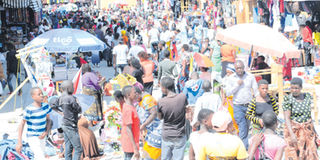‘A lot of investment needed to relocate Mbeya petty traders’

It is business as usual for hawkers at the Mwanjelwa Main Market in Mbeya City. Efforts to relocate hawkers from the city centre have been hampered by lack of conducive environment in designated areas. PHOTO | GODFREY KAHANGO
What you need to know:
- The head of Markets of Mbeya City Council, Mr Innocent Komba, says despite designating the ten areas that can accommodate 6,970 hawkers, relocation would have to wait for the construction of the market infrastructure, public amenities and security fences.
Mbeya. The Mbeya City Council has to construct at least 10 hawkers’ markets before the relocation of the informal traders starts.
The head of Markets of Mbeya City Council, Mr Innocent Komba, says despite designating the ten areas that can accommodate 6,970 hawkers, relocation would have to wait for the construction of the market infrastructure, public amenities and security fences.
“We have allocated the areas but the challenge remains that they are not yet business friendly. A lot of investment is needed to prepare the facilities before we can move hawkers to those places,” Mr Komba said, without saying how much money is needed.
He mentioned the 10 areas with the number of stalls in brackets as the Nanenane Bus Terminal Market located at Ilomba Ward (1,200), Maghorofani Market in Forest ward (500), Sokoine Market in Sisimba Ward (70), Itezi Market in Itezi Ward (1,000) Nsalaga Market in Nsalaga Ward (1,000).
Other areas are Barabara ya Bulongwa market in Maanga Ward (500), Moon Dust at Soweto Ward (200), Uwanja wa John Mwakangale Market in Isyesye Ward (1,200), the Tanzania Institute of Accountancy Market in Iyela ward (300) and the Block T Market (1,000). No single hawker has moved to any of these areas because the facilities are not yet ready.
“In some of these areas there are not public toilets, no running water. Security is also a problem. There are neither security fences nor secured entrances,” Mr Komba says.
Mbeya, like many other cities and major urban centres in Tanzania, is struggling with the problem of hawkers that is denying local authorities the much needed revenue. About 3000 hawkers, according to some estimates, sell their wares on street pavements at the city centre and along the Tanzania-Zambia highway that passes in the city and in other busy trade centres.
The City Council has been evicting them and sending them to open spaces around the city but they have always found their way back. Following President John Magufuli’s order that hawkers should not be disturbed they have gone back to the central business district almost with a vengeance at the expense of shopkeepers and other registered traders.
Following the presidential directive Mbeya Regional Commissioner Amos Makalla allowed hawkers to construct their stalls even inside the new Mwanjelwa Market and in the Kabwe bus stop.
Mr Makalla also allowed them to construct stalls in the Uhindini Market that was ravaged by fire in 2006, something that has raised questions about the plans of the City Council to build a ultra-modern market in the area. City authorities say hawkers will have to be relocated when all preparations are made. The chairman of the Hawkers Association in Mwanjelwa, Mr Dickson Kalapila, urged city authorities to hasten preparing the designated areas because hawkers were tired of being evicted from the city streets.
He, however, warns about isolating hawkers in specific areas because, he argues, informal traders work in a symbiotic relationship with medium and large, formal traders.
“We get our merchandise from big traders. But because our operating capital is so small they give us on credit and we pay back at the end of every day. Isolating us is making our business so difficult,” Mr Kalapila said, adding that this has been the reason for the return of most hawkers to busy trade centres after every eviction in the past.




